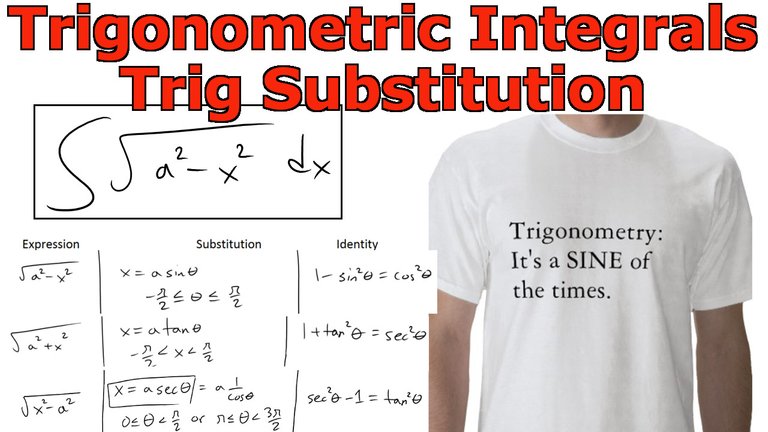Trigonometric Substitution for Integrals
In this video I go over the method of trig substitution for integrals which allows us to solve for the integrals of functions that involve circular or ellipse like equations. The method involves using the substitution rule for integrals but in reverse and this time defining the old variable as a function of the new as opposed to the other way around. This is a very useful method for evaluating integrals so make sure to watch this video!
Watch Video On:
- DTube: https://d.tube/#!/v/mes/saru2j1jke8
- BitChute: https://www.bitchute.com/video/t4HYJKciDouu/
- YouTube: https://youtu.be/2pWvGXwtVJo
Download Video Notes: http://1drv.ms/1A7Znny
View Video Notes Below!
Download These Notes: Link is in Video Description.
View These Notes as an Article: https://steemit.com/@mes
Subscribe via Email: http://mes.fm/subscribe
Donate! :) https://mes.fm/donateReuse of My Videos:
- Feel free to make use of / re-upload / monetize my videos as long as you provide a link to the original video.
Fight Back Against Censorship:
- Bookmark sites/channels/accounts and check periodically
- Remember to always archive website pages in case they get deleted/changed.
Join my private Discord Chat Room: https://mes.fm/chatroom
Check out my Reddit and Voat Math Forums:
Buy "Where Did The Towers Go?" by Dr. Judy Wood: https://mes.fm/judywoodbook
Follow My #FreeEnergy Video Series: https://mes.fm/freeenergy-playlist
Watch my #AntiGravity Video Series: https://steemit.com/antigravity/@mes/series
- See Part 6 for my Self Appointed PhD and #MESDuality Breakthrough Concept!
Follow My #MESExperiments Video Series: https://steemit.com/mesexperiments/@mes/list
NOTE #1: If you don't have time to watch this whole video:
- Skip to the end for Summary and Conclusions (If Available)
- Play this video at a faster speed.
-- TOP SECRET LIFE HACK: Your brain gets used to faster speed. (#Try2xSpeed)
-- Try 4X+ Speed by Browser Extensions or Modifying Source Code.
-- Browser Extension Recommendation: https://mes.fm/videospeed-extension
-- See my tutorial to learn more: https://steemit.com/video/@mes/play-videos-at-faster-or-slower-speeds-on-any-website- Download and Read Notes.
- Read notes on Steemit #GetOnSteem
- Watch the video in parts.
NOTE #2: If video volume is too low at any part of the video:
- Download this Browser Extension Recommendation: https://mes.fm/volume-extension
Trigonometric Integrals: Substitution

In finding the area of a circle or an ellipse, an integral of the form below arises:

but if it were in the form:

We could use substitution:

But as it stands the first integral is more difficult.
If we, instead, apply a trig substitution in the form:

Notice the difference between the two substitutions:
(1) The new variable, u, is a function of the old variable, x:

(2) The old variable, x, is a function of the new variable, Ѳ:

In general we can make a substitution of the form x = g(t) by using the Substitution Rule in reverse.
To make our calculations simpler, we assume that g has an inverse function; that is, g is one-to-one function (see my earlier video in the description).

In this case, we can re-write the substitution rule:

by replacing u with x and x by t:

This kind of substitution is called Inverse Substitution
We can make the inverse substitution x = a·sinѲ provided that it defines a one-to-one function. This can be accomplished by restricting Ѳ to lie in the interval [-π/2, π/2].

In the following table is a list of trigonometric substitutions that are effective for the given radical expression because of the specified trig identities. In each case the restriction on Ѳ is imposed to ensure that the function that defines the substitution is one-to-one. (These are the same intervals I used in my earlier videos on inverse trig functions)


Hello,
Your post has been manually curated by a @stem.steem curator.
We are dedicated to supporting great content, like yours on the STEMGeeks tribe.
Please join us on discord.